
Las Grutas de Cacahuamilpa, MEXICO
Translate:
EspaŮol - FranÁais
- Deutsch
- Italiano
- PortuguÍs
- Japanese
- Korean
- Chinese

Las Grutas de Cacahuamilpa, MEXICO
Translate:
EspaŮol - FranÁais
- Deutsch
- Italiano
- PortuguÍs
- Japanese
- Korean
- Chinese

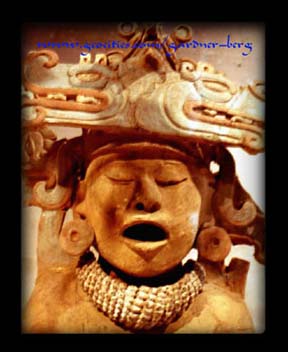
April 13, 1999 -- We took a 6 hour bus ride from Mexico City to the small town of Papantla located close to the Gulf coast in the Veracruz state - also the centre of a very large vanilla-producing zone.
About 12 kms SW of the town are the ruins of El Tajin - the capital of the Totonac Culture (6th to 10th century). El Tajin (meaning 'the hurricane') is a very intersting complex to walk around. At the centre of the site is the Pyramid of the Niches. An impressive structure with 365 squared openings making it resemble a giant beehive. Totonac rain dancers perform a ritual which involves 4 flyers (voladores) and a musician with a pipe and drum to climb a 30m mast with a rotating structure on top. There, the musician dances to his music while the roped voladores throw themselves off the top platform to the ground in a spiralling descent.
 April 15, 1999 -- We leave Papantla on a 4 and a half hour bus ride to Xalapa (also spelt Jalapa) - the capital of the Veracruz state. It is an upbeat colonial city, home of the University of Veracruz and on its surrounding hillslopes, coffee and tobacco is cultivated. The city's museum - Museo de Antropologia housed archeological treasures of the Olmec, Totonac and Huaxtec coastal cultures. But what fascinated us the most were the 7 colossal stone heads of the Olmec culture.
April 15, 1999 -- We leave Papantla on a 4 and a half hour bus ride to Xalapa (also spelt Jalapa) - the capital of the Veracruz state. It is an upbeat colonial city, home of the University of Veracruz and on its surrounding hillslopes, coffee and tobacco is cultivated. The city's museum - Museo de Antropologia housed archeological treasures of the Olmec, Totonac and Huaxtec coastal cultures. But what fascinated us the most were the 7 colossal stone heads of the Olmec culture.
The Olmecs, it is believed, created the first important civilisation of central Mexico, around 1200 BC, on the coastal areas of the Gulf of Mexico in today's southern Veracruz and Tabasco states. They flourished for about 700 years, reaching a population of perhaps 350,000 mostly occupying 3 important cities - known today as La Venta, San Lorenzo and Tres Zapotes - before disappearing. Their jewellery and pottery that remains today in museums, indicate a race of great artistic talent and religious sensitivity. The outstanding features of the stone heads have puzzled archeologists with their broad noses and thick lips; laying claim by some that there may have been African influence in the New World long before the arrival of the Europeans. There are also stone stelae found that point to an advanced dating system which included the concept of zero, unknown to their Roman contemporaries.
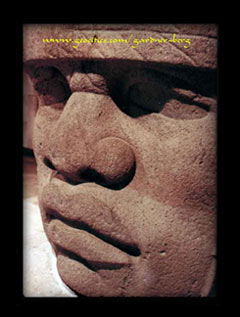
There was also Olmec influence of the Mayas to the SE and the emerging highland civilisations to the west where their principal symbol, the jaguar, can still be found as far south as El Baul in Guatemala and as far west as Tula. But, interestingly, unlike other local civilisations, they were not warriors. This 'empire' seemed to have grown through trade and religion. Very little is known about these people. No tribe exists today that can be traced to them. No one knows why they settled here, why they developed more than others, how they lived, how their political and religious structures functioned and why their civilisation finally 'disappeared'.
We would agree, to some extent, that they may have been assimilated with other groups such as the Mayas or the Aztecs. Certain aspects of Olmec influence can be seen in the sculptures and frescoes. But there is a need for more evidence.
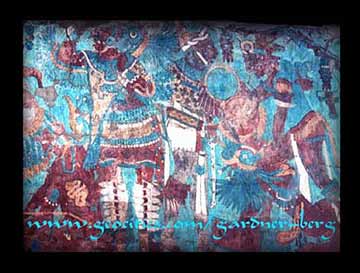
April 17, 1999 -- From Xalapa we move on to Puebla - a little inland west. Arrival at Puebla's modern bus station suggested that it is a city of affluence. There are churches everywhere surrounded by thousands of colonial-style architecture decorated with handpainted ceramic tiles (Talavera tiles) of which this city is famous for. Founded in 1531 by Fray Julian Garces - it is said that he saw angels in a dream indicating where the city should be built. Unlike many of Mexico's colonial cities, Puebla wasn't built using Indian ruins as a foundation. It's a very nice city with friendly people - a popular destination for foreign travellers.
April 18 -- 35 km NW of the city are the ruins of Cacaxtla and Xochitcatl.
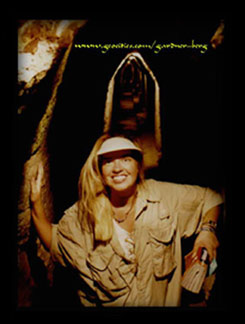 Cacaxtla has a series of precolumbian frescos still depicting images in sharp colour, and the figures are larger than life. There is one wall in turquoise, showing a battle scene between an army dressed as jaguars and another dressed as eagles. Symbolically, the jaguar and the eagle represent the opposing characteristics much like the 'Yin and Yang' of eastern cultures: the jaguar represents - Venus, night, the rainy season, North, and death; while the eagle represents - the Sun, day, the dry season, South and life.
Cacaxtla has a series of precolumbian frescos still depicting images in sharp colour, and the figures are larger than life. There is one wall in turquoise, showing a battle scene between an army dressed as jaguars and another dressed as eagles. Symbolically, the jaguar and the eagle represent the opposing characteristics much like the 'Yin and Yang' of eastern cultures: the jaguar represents - Venus, night, the rainy season, North, and death; while the eagle represents - the Sun, day, the dry season, South and life.
A 2 km walk across some farmland, we arrived at Xochitecatl, being a group of pyramids speculated to have been used to honor fertility gods.
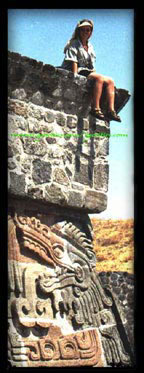 April 19, 1999 -- We head to Cholula for a day - a small town 10 km west of Puebla to view another pyramid. This one is situated right in the centre of town, is partially uncovered and has a yellow and white church built on top of it (Los
Remidios). In actual fact, the 'pyramid' is a series of pyramids built on top of each other (as in Mexico City's 'Templo Mayor' ruins). Archeologists have, so far, uncovered 8 kms of tunnels within the 'pyramid'. But,unfortunately, we only had access to 1 km of them. It was interesting all the same. We would go into one side entrance and pop out the other side of the church where the rest of the ruins, including th sacrificial sites complete with human remains (encased in glass), are in full view. Very exciting.
April 19, 1999 -- We head to Cholula for a day - a small town 10 km west of Puebla to view another pyramid. This one is situated right in the centre of town, is partially uncovered and has a yellow and white church built on top of it (Los
Remidios). In actual fact, the 'pyramid' is a series of pyramids built on top of each other (as in Mexico City's 'Templo Mayor' ruins). Archeologists have, so far, uncovered 8 kms of tunnels within the 'pyramid'. But,unfortunately, we only had access to 1 km of them. It was interesting all the same. We would go into one side entrance and pop out the other side of the church where the rest of the ruins, including th sacrificial sites complete with human remains (encased in glass), are in full view. Very exciting.
Cholula is home for the University of th Americas where students from around the world come to study. Also, the Volkswagon maquiladora runs an operation here - VW is a very popular make of vehicle in Mexico.
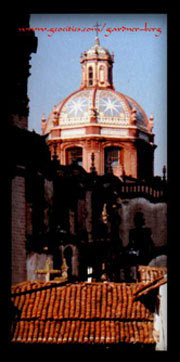 Our next destination is Cuernavaca - 4 and a half hours by bus from Puebla. A holiday and weekend retreat for Mexico City's upper class as well as foreign tourists. It's colonial character has been lost due to the city's rapid growth and new industrial zones to the south. It's a very expensive city to visit, so we made a big effort to keep our stay short.
Our next destination is Cuernavaca - 4 and a half hours by bus from Puebla. A holiday and weekend retreat for Mexico City's upper class as well as foreign tourists. It's colonial character has been lost due to the city's rapid growth and new industrial zones to the south. It's a very expensive city to visit, so we made a big effort to keep our stay short.
The next day we catch a bus to the Xochicalco junction, then walk 4 kms to the ruins. This ancient fortress is one of the oldest of its kind in Middle America. It was at its height between 650 and 900 AD. Th site is large and is highlighted by the impressive Pyramid of the Plumed Serpent. Its sides are faced with rock slabs fitted without mortar. The carvings are a detailed representation of a plumed serpent where its coils wrap completely around the 4 sides. There are also some underground tunnels. One, in particular, has a vertical shaft above where light from the sun enters to illuminate the centre of the floor. It functions very much like the aperture of a camera.
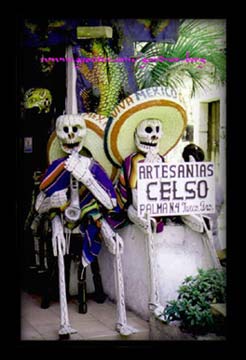 This ancient observatory was used by priests to correlate their calender system. During most of the year, the circle of light on the floor has hazy or blurry edges. But at certain times of the year, e.g. the solstices, the earth is in a particular
position in its orbit around the sun. At this point, the light entering from the shaft is so strong and sharp that the whole chamber is illuminated. These occurences were recorded and predictions were made as to when to plant their crops.
This ancient observatory was used by priests to correlate their calender system. During most of the year, the circle of light on the floor has hazy or blurry edges. But at certain times of the year, e.g. the solstices, the earth is in a particular
position in its orbit around the sun. At this point, the light entering from the shaft is so strong and sharp that the whole chamber is illuminated. These occurences were recorded and predictions were made as to when to plant their crops.
When the guard at the tunnel entrance explained this concept to us - we just reeled back in amazement at the thought that these ancient civilisations had, at their disposal, the kind of knowledge the we would consider today as modern, practical science (without the use of high-tech equipment).
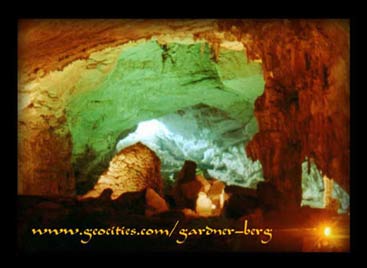 The next destination was Taxco, 1 and a half hour bus ride SW of Cuernavaca. Very popular with tourists because of its antique colonial character - so much
so that the town itself is officially a historical national monument. It was once a booming silver mining town during the Spanish conquest of which a couple of certain Spaniard individuals made a huge fortune out of. Not much is left today, but you can buy silver quite cheaply (purity at 92.5%) at the zocalo markets. We took a day trip out of Taxco to check out some caves at a village called Cacahuamilpa - practically in the middle of nowhere. It turns out that these caverns are one of the largest in North America. They were spectacular,
estimated maximum depth is 16 km. With its odd-shaped stalactite and stalagmite formations as a natural backdrop, part of the caves were reserved as a concert staging area. No need for electronic equipment; whispers are amplified to a very large degree.
The next destination was Taxco, 1 and a half hour bus ride SW of Cuernavaca. Very popular with tourists because of its antique colonial character - so much
so that the town itself is officially a historical national monument. It was once a booming silver mining town during the Spanish conquest of which a couple of certain Spaniard individuals made a huge fortune out of. Not much is left today, but you can buy silver quite cheaply (purity at 92.5%) at the zocalo markets. We took a day trip out of Taxco to check out some caves at a village called Cacahuamilpa - practically in the middle of nowhere. It turns out that these caverns are one of the largest in North America. They were spectacular,
estimated maximum depth is 16 km. With its odd-shaped stalactite and stalagmite formations as a natural backdrop, part of the caves were reserved as a concert staging area. No need for electronic equipment; whispers are amplified to a very large degree.
Photos and Text Copyright © 1999-2001 Gardner-Berg. All rights reserved.
Sources of Further Reading-
Benson, Elizabeth P. Olmec Art of Ancient Mexico.
Coe, Michael D. The Olmec World: Ritual and Rulership. 1996

